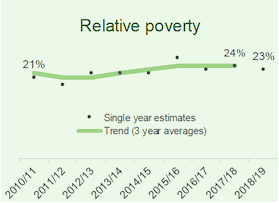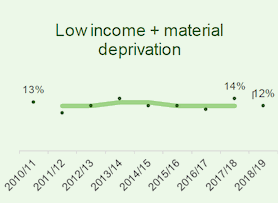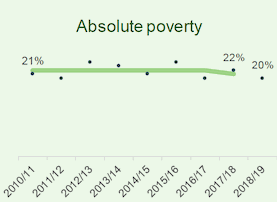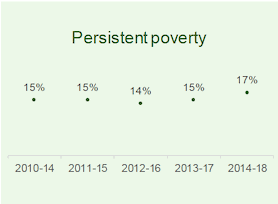Tackling child poverty: second year progress report (2019-2020)
The second annual progress report for 'Every child, every chance: tackling child poverty delivery plan 2018-2022'.
2. Assessing progress against the targets
Child poverty levels
The most recent child poverty statistics, published in March 2020, relate to the period from April 2018 to March 2019. They are the first statistics that cover the period after the Delivery Plan was published in June 2018. Persistent poverty statistics that cover the period after the Delivery Plan was published are not yet available.
| Latest statistics | 2023 target | 2030 target | |
|---|---|---|---|
| % of children in relative poverty | 23% (2018-19) | 18% | 10% |
| % of children in absolute poverty | 20% (2018-19) | 14% | 5% |
| % of children in low income + material deprivation | 12% (2018-19) | 8% | 5% |
| % of children in persistent poverty | 17% (2014-18) | 8% | 5% |
The charts below show change over time. While single-year estimates can be used to understand the situation at a certain point in time, three-year averages show trends more accurately. Relative child poverty had been gradually rising for several years, but has not risen in recent years. Absolute child poverty, and the proportion of children who are in combined low income and material deprivation, have remained relatively stable. Persistent child poverty appears to have risen slightly, but it is too early to say whether this indicates a trend[43].




Child poverty is lower in Scotland than it is in the UK as a whole. This is important, because child poverty levels in Scotland are influenced by many different factors, only some of which can be influenced by public policy in Scotland. Looking at the UK data helps us to account for the impact of UK-wide factors, such as the elements of the social security system that are reserved to the UK Government.
| Scotland | UK | |
|---|---|---|
| % of children in relative poverty 2018-19 | 23% | 30% |
| % of children in absolute poverty 2018-19 | 20% | 28% |
| % of children in low income + material deprivation 2018-19 | 12% | 14% |
| % of children in persistent poverty 2014-18 | 17% | 20% |
The 2018-19 child poverty levels in Scotland are also lower than independent forecasts, published in 2018 and 2019[44], had predicted they would be.
The drivers of child poverty
To help understand what is driving child poverty trends over time, it is important to examine progress in relation to the things that we know influence child poverty levels, including employment, costs of living and social security. Clearly, if child poverty levels are to improve, there will need to be a change in these areas. As mentioned above, not all of the levers for change have been devolved to the Scottish Government. A set of benefits related to disability and carers, and some payments for low-income households, are in the process of being transferred[45]. But responsibility for the main means-tested benefits (including Universal Credit, with some flexibility over payment options known as ‘Scottish Choices’) remains reserved to the UK Parliament[46]. Employment law, including powers over minimum wage levels, is also reserved, although the Scottish Government recognises that it has an important leadership role in promoting fair work[47].
Trend data for the drivers of child poverty are presented in Annex A, and Annex B explores how Scotland compares to the rest of the UK in relation to these drivers. The evidence presented in these annexes is summarised below. It should be noted that this evidence pre-dates the COVID pandemic, which is adversely impacting household incomes as many workers have been made redundant, furloughed or have had their working hours or wages cut.
Key employment indicators of participation, underemployment and hourly pay are all moving in the right direction, and hours worked have remained stable. The figures for Scotland are very similar to those for the UK as a whole. The percentage of parents with no or low qualifications, and the percentage of employed working age parents with degrees who are in low or medium skilled occupations, have been relatively stable, and are slightly lower than the equivalent UK figures.
Availability of flexible childcare during the school holidays has stayed the same, but has continued to improve slowly outside of school hours. Over a quarter of households paying for childcare for a pre-school child aged 2+ say they find it difficult or very difficult to afford childcare.
While the percentage of income spent on housing by all households with children in Scotland has been slowly decreasing, the percentage spent by low income households with children has been relatively stable. The figures do, however, compare favourably with those in the UK as a whole. This aligns with the fact that, whereas Scotland has lower levels of child poverty than the UK after housing costs have been taken into account, the before housing costs figures are very similar.
It is less affordable for low income households in Scotland than those in England to heat their homes adequately, although affordability in Scotland is gradually improving. The percentage of families in unmanageable debt has stayed roughly the same as the last reporting period, and is lower in Scotland than in the UK as a whole.
The downward trend in the real terms value of UK-wide social security payment continues.
Evaluating our policies
Updates on individual policy evaluations are provided in section 1 of this progress report. As set out in the evaluation strategy[48], our evaluation efforts have been focused on those actions likely to have the biggest impact on the child poverty targets.
The Scottish Government’s ‘Tackling Child Poverty Delivery Plan 2018-2022’ also made a commitment to investigate methods to produce a quantitative, cumulative impact assessment of the policies on child poverty:
“Over the next few years, we will scope out and develop tools to help us analyse the full range of policies [in Delivery Plan], with the intention of being able to produce quantitative estimates of the impact of future interventions on the poverty targets…Our ambition is to build a modelling tool that [enables us] to understand the likely quantitative impact of poverty reduction policies in the future.”[49]
The Delivery Plan recognised the importance of this kind of modelling for assessing the impact of existing policies, monitoring progress towards the child poverty targets, and informing the design of future policies.
There are three stages to our work to develop a modelling tool and use it to produce analysis on child poverty:
1. Scoping and initiation: selecting the most appropriate model, developing our skills in how to use it, and adapting the model to suit our needs.
Following a detailed assessment of the options, we have selected UKMOD, a tax-and-benefit micro-simulation model held by the Institute of Social and Economic Research (ISER) at the University of Essex. ISER has provided us with advanced training on how to use the model. And we have adapted the model to suit our needs, including projecting the model forward from 2020/21 (the latest year in the model) to 2023/24 (the year of the interim child poverty targets) and adjusting the definition of disability to match our official statistics.
2. Preliminary analysis: using the model to produce an analysis of a limited package of policies, within the existing capabilities of the model.
Unfortunately, coronavirus has had a significant impact on this stage of the work. We had completed the preliminary analysis, modelling the impact of a package of seven cash-transfer policies[50] on the child poverty targets. However, the data on which it is based do not take into account the economic effects of the pandemic, meaning the results are no longer reliable. Therefore, we do not intend to publish them at this stage.
3. Further analysis: developing methods and gathering data to apply the model to a wider range of policies and scenarios.
It will be necessary for us to get a picture of the post-coronavirus world before we can produce any further meaningful analysis using UKMOD. As part of the process of estimating poverty rates, UKMOD applies a number of macroeconomic forecasts. At present, there is significant uncertainty around these forecasts, and therefore on any projection of the impact of COVID-19 on household incomes and poverty rates. As more robust forecasts become available, we plan to prioritise building these into the model.
Child poverty priority groups
The priority groups identified in the Delivery Plan remain at a higher than average risk of poverty[51].
| Relative poverty | Absolute poverty | Low income + material deprivation | |
|---|---|---|---|
| Disabled person in household | 30% | 27% | 20% |
| 3+ children in household | 31% | 28% | 18% |
| Baby aged under 1 in household | 32% | 30% | 13% |
| Minority ethnic household | 44% | 41% | 23% |
| Lone parent household | 39% | 34% | 27% |
| All children | 24% | 21% | 12% |
Percentage of children in persistent poverty after housing costs 2014-18 (Source: Understanding Society)
| Disabled adult in benefit unit | 18% |
|---|---|
| 3+ children in benefit unit | 38% |
| All children | 17% |
Last year’s progress report took a more in-depth look at child poverty and its drivers among minority ethnic families[52]. Annex C of this year’s report focuses on another of the priority groups: lone parent families.
It is important to make sure that our policies are reaching and meeting the needs of the priority groups. Where possible, the individual policy evaluations are exploring the extent to which this is the case. The cumulative impact modelling we have been developing, discussed above, will also allow us to explore whether impacts vary between families with different characteristics.
Contact
Email: sjsu@gov.scot
There is a problem
Thanks for your feedback